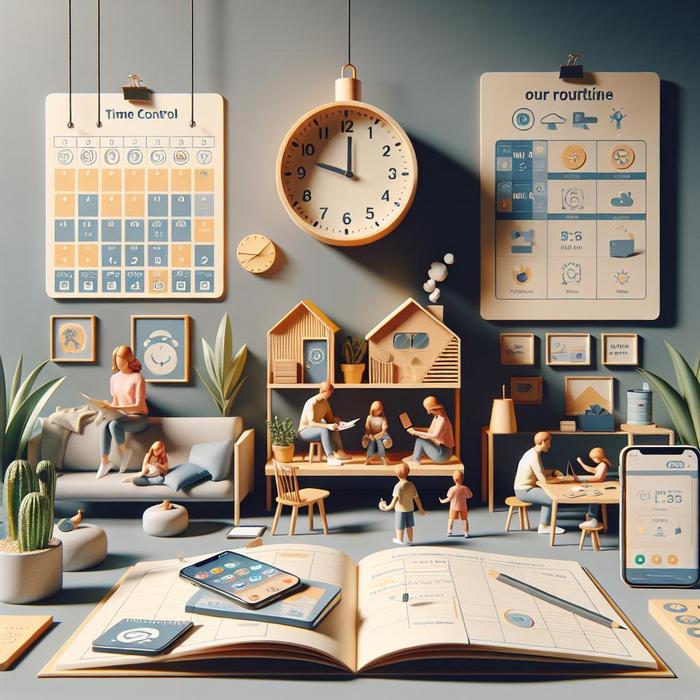Establishing and Managing Screen Time Routines
We live in a digital age where screens, such as televisions, laptops, tablets, and smartphones, have become ubiquitous in our lives. As parents, one of the most pressing challenges we grapple with is managing screen time for our children.
Finding the perfect balance of technological use is more than just setting a timer. It involves creating routines, fostering a healthy relationship with technology, and fostering a nurturing environment for our children’s growth and development.
Identifying the Challenge of Balancing Technology Use
The challenge of balancing technology use lies in managing the benefits and drawbacks of screen time. While devices can be incredibly educational and open up new worlds of knowledge and entertainment, excessive usage can lead to a myriad of problems, including sleep disorders, impaired social skills, and unhealthy lifestyle habits.
An article by Alberta Health Services provides a comprehensive overview of these issues, emphasizing the importance of well-managed screen time.
Developing a Technique for Managing Screen Time
Creating routines that effectively manage screen time needs a well-thought-out approach. Here’s how:
- Set Clear Boundaries: Establish rules on when and where devices can be used. For instance, no screens during meal times or an hour before bed. This can help minimize screen-time-associated problems like sleep disorders.
- Encourage Physical Activity: Incorporate regular physical outdoor activities into your child’s schedule. This helps to keep them active and reduces their dependency on devices for entertainment.
- Balance with Educational Content: Not all screen time is equal. Educational programs or apps can be beneficial for your child’s learning process.
- Use Devices Together: Make screen time an interactive family activity. This approach can promote bonding while allowing you to regulate what they watch and for how long.
- Lead by Example: Children often imitate adult behavior. Balancing your own screen time can set a positive example.
Our Experience with Creating Routines
In our quest to manage screen time, we found that what worked for one family might not work for another. It’s all about understanding your child’s behaviors, interests, and needs. It’s also about being flexible and willing to adjust your strategies along the way.
One of our most successful approaches was incorporating mindfulness into our parenting. We have shared our journey in a previous article on how we incorporate mindfulness in our parenting approach.
However, managing screen time is not a one-time solution. It’s an ongoing process that requires regular reevaluation and adjustment. For more insight on how we continuously adapt our methods, you can explore our article on the parenting books and resources that have made a difference for us.
Final Thoughts and Tips on Digital Parenting
Digital parenting takes patience and persistence, but with the right approach, managing screen time can be a breeze. You are not just curbing excessive screen time but shaping your child’s relationship with technology for the future. So strive to make it positive.
Will there be challenges along the way? Undeniably. Will there be days when our carefully crafted routines won’t work? Definitely. However, each day is a new opportunity to reset, readjust, and reignite the pursuit of balanced digital parenting.
Interested in understanding the perspective of other parents on managing screen time? Here’s an enlightening article by Vani Kola on the subject.
Expert Insights on Screen Time Management
Understanding the effects of screen time is not just beneficial, but necessary for modern parenting. According to an article by Qustodio, excessive screen time can affect not just physical health but also mental wellness. It can lead to reduced attention spans, lower quality sleep, and even increased risk of depression.
Mayo Clinic emphasizes the importance of children engaging in alternative activities – such as physical play, reading, and face-to-face interactions – to provide balance and reduce the risk of negative effects associated with screen use.
Manage Your Screen Time All Day Long
Strategic methods for managing screen time can be very beneficial not only for children but adults as well. Business Insider offers some practical advice on creating a more efficient phone routine, suggesting specific times of day to engage with our devices, such as after exercising in the morning or during allocated “screen breaks” during the day. Importantly, they advise having technology-free zones immediately before sleep to promote better rest.
A study Busy Toddler suggests breaks at least every hour to allow our brains to rest and reboot, maintaining our focus and preventing digital fatigue.
Creating a Healthy Digital Environment
Maintaining a healthy digital environment is a collective effort. Encourage these habits:
- Promote Open Conversations: Talk openly about the possible risks and benefits of screen use. Make your child feel involved in establishing screen limits and guidelines.
- Stay Informed: Stay updated about the latest apps, websites, and digital trends that your child is interested in. Knowledge about their digital world can make you a better ally for them.
- Create Technology-Free Zones: Have specific areas in the house where screen use is prohibited, such as the dinner table or bedrooms.
- Encourage Diverse Activities: Encourage your child to engage in various activities that do not involve screens. This could involve reading, art, outdoors activities, or games.
Parenting in the Digital Age
Moving forward in this digital age, our parenting will inevitably involve managing our children’s screen use effectively. And while that might seem like a daunting task, by staying informed and implementing strategies that work for your family, it becomes a manageable aspect of modern parenting.
Remember, each family and each child is unique; so what worked for others might not necessarily work for you. However, by staying flexible, patient, and committed, you can efficiently navigate this aspect of parenting. Just remember – as the parent, you set the tone. So make screen time management a priority, and don’t forget to lead by example.

